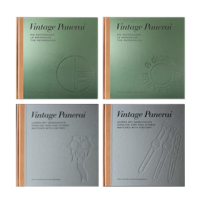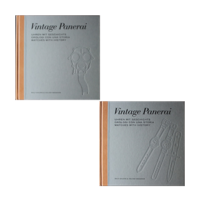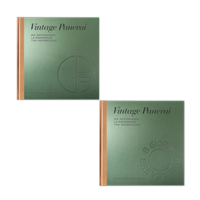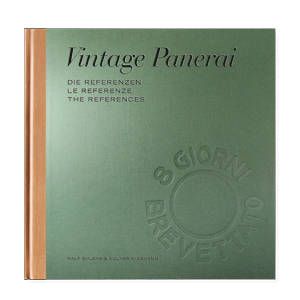Tag: 3646
Reading a frogman’s battle report…
by Volker on May.03, 2024, under Allgemein
One of the rarest historical documents which we came across during the research of our book “History2”: a handwritten battle report of a frogmen mission at the Pomeranian coast, dated April 3rd, 1945.
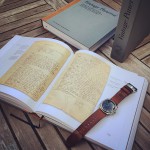 Documents from the last weeks of the Second World War are today, without a doubt, very hard to find – if existing after more than 70 years at all… With the support of the family of the German “Kampfschwimmer”, who once wrote this report after he returned safely from the combat zone, we were able to include this battle report (page 672-673 shown on the coffee table shot on the left) in chapter VII of “History2” (featuring the chapters V-IX with a total of 480 pages).
Documents from the last weeks of the Second World War are today, without a doubt, very hard to find – if existing after more than 70 years at all… With the support of the family of the German “Kampfschwimmer”, who once wrote this report after he returned safely from the combat zone, we were able to include this battle report (page 672-673 shown on the coffee table shot on the left) in chapter VII of “History2” (featuring the chapters V-IX with a total of 480 pages).
Interesting details in his handwritten battle report are the times which he mentioned aside other details, all easily readable on the sandwich dial of the Ref. 3646 / Type D (with 5 minute markers / indices) he was wearing during the mission: He wrote down 21:50, 23:30, 23:45, 23:50-0:30 and finally 2:05 AM – the moment he left the waters – after 4:15 hours trying to attack the Wollin railroad bridge together with a group of four frogmen from the “Einsatzgruppe Keller”, towing two mines thru the waters of the Dievenow.
One of these five frogmen is featured in our book “History1”. Several pages of his diary are published in chapter II, where he wrote down what happened during the frogmen attack of the Gristow bridge at the Pomeranian coast (page 134-143).
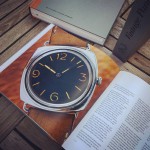 Read more on further rare documents which helped us to capture the history behind the Ref. 3646 / Type D “Kampfschwimmer” watch, shown on the coffee table shot on the left here. Photos from the years 1944 and 1945 showing this watch on the frogman’s wrist, as well as his identification papers and travel documents issued in Venice, helped us to reconstruct the route he took to the mission grounds.
Read more on further rare documents which helped us to capture the history behind the Ref. 3646 / Type D “Kampfschwimmer” watch, shown on the coffee table shot on the left here. Photos from the years 1944 and 1945 showing this watch on the frogman’s wrist, as well as his identification papers and travel documents issued in Venice, helped us to reconstruct the route he took to the mission grounds.
Obviously his handwritten battle report never reached the headquarters but somehow he managed to keep it safe for his personal records, giving us today, more than 70 years later, a detailed inside view on a mission he carried out together with four frogmen at the Eastern Front in April 1945…
Our two “History” books can be ordered only in our bookstore.
Enjoy reading stories behind these watches!
[Ralf Ehlers & Volker Wiegmann]
“Operazione Stella” – Luigi Ferraro’s Panerai watch
by Volker on Mar.08, 2024, under Allgemein
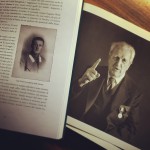 A “Gamma” frogman who wrote history. A photo from 1998 which was a reminder not to miss the chance to capture Luigi Ferraro’s story in our book “The References” – together with the 3646 / Type B watch he was wearing during the “Operazione Stella” in 1943.
A “Gamma” frogman who wrote history. A photo from 1998 which was a reminder not to miss the chance to capture Luigi Ferraro’s story in our book “The References” – together with the 3646 / Type B watch he was wearing during the “Operazione Stella” in 1943.
One of the few watches which can be followed back to the first owner, which is also a very famous one: Luigi Ferraro (M.O.V.M.). Not easy to capture as much as possible of his story in a part in the first volume of “The References”, which filled several books of Italian authors with hundreds of pages. Even in the first Panerai books, written by Giampiero Negretti in 1998, Luigi Ferraro’s famous missions in the mediterranean sea found their place to be mentioned.
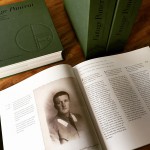 To get in touch with the family of the veteran Luigi Ferraro (1914-2006) was a very intensive and exciting time during the research about his Ref. 3646 / Type B “Radiomir Panerai” with riveted plastic dial (chapter II.II page 190-203). Paolo Ferraro, one of Luigi Ferraro sons, provided excellent photos and made personal documents available for us to be featured in our book, which gave us the chance to illustrate the history behind his father’s watch.
To get in touch with the family of the veteran Luigi Ferraro (1914-2006) was a very intensive and exciting time during the research about his Ref. 3646 / Type B “Radiomir Panerai” with riveted plastic dial (chapter II.II page 190-203). Paolo Ferraro, one of Luigi Ferraro sons, provided excellent photos and made personal documents available for us to be featured in our book, which gave us the chance to illustrate the history behind his father’s watch.
In January 1943 Luigi Ferraro obtained his qualification to carry out underwater missions. Initially posted to North Africa to attack enemy targets in the Port of Tripoli, he had to leave the area and returned to Italy. In May 1943 he was posted to La Spezia, where he received instructions from commander Borghese for a new mission – this time not in North Africa, but in the eastern Mediterranean: the Turkish ports of Alexandretta and Mersina. Luigi Ferraro’s four “Stella” missions, for which he was awarded with the M.O.V.M., are described in chapter II.II (page 204-225).
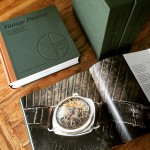 Aside several tools of his time as a “Gamma” frogman, Luigi Ferraro’s 3646 / Type B “Radiomir Panerai” never changed ownership and remained a memorable piece for him and his family since he returned from war. The watch shows intensive proof of aging and is an example of how different these rare watches have aged after more than 70 years. The watch still has its original strap, as well as its original domed plexiglas crystal – intensively aged with countless fissures. Numbers, indices and the typical “Radiomir Panerai” lettering on the riveted plastic dial can still be made out at some points.
Aside several tools of his time as a “Gamma” frogman, Luigi Ferraro’s 3646 / Type B “Radiomir Panerai” never changed ownership and remained a memorable piece for him and his family since he returned from war. The watch shows intensive proof of aging and is an example of how different these rare watches have aged after more than 70 years. The watch still has its original strap, as well as its original domed plexiglas crystal – intensively aged with countless fissures. Numbers, indices and the typical “Radiomir Panerai” lettering on the riveted plastic dial can still be made out at some points.
Luigi Ferraro’s watch has been recorded in our database in 2014, however the watch was known to us already years before. The Rolex 618 / Type 1 movement in combination with the small Oyster Watch Co hallmark, embossed on the inner caseback together with the reference and case number, is matching our criteria for being a watch of the Reference 3646 / Type B. The outer caseback bears a rare matriculation number, of which only a very few 3646 watches are known today. We have published further information about the different matriculation numbers on some of these watches in chapter II.III (page 301-303).
Luigi Ferraro’s 3646 / Type B “Radiomir Panerai” with riveted plastic dial is published extensively in chapter II.II (page 190-203) of the book “The References” 1930’s-1940’s.
More 3646 watches with an interesting history, related to their first owners and the missions they carried out during the Second World War, are introduced in chapter II.I (Ernesto Notari) and in chapter II.III (Licio Visintini). Enjoy reading!
How to visualize a frogman’s pencil written diary from 1945?
by Volker on Feb.16, 2024, under General
During the research on the history behind a Ref. 3646 / Type D “Kampfschwimmer” with engraved caseback, we were able to study the diary of the first owner of the watch. This diary survived the last days of the Second World War and the veteran kept it for decades, willed to share it with us and partially featured in chapter II of our book “History2”.
Thanks to the many detailed descriptions (e.g. the water temperature, current, weather conditions and explosive charges carried) which the frogman wrote down and the examination of historical maps of the 1940’s it was possible to analyze his diary entries precisely and visualize his memories to the readers of our book in an impressive way. The collected documents and additional information let this chapter become one of the unique stories behind a Ref. 3646 / Type D “Kampfschwimmer” watch.
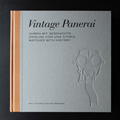 Reading page 83 of “History1” reminds on a part of our research which did happened not often. The frogman wrote the following lines in his diary at the beginning of March 1945:
Reading page 83 of “History1” reminds on a part of our research which did happened not often. The frogman wrote the following lines in his diary at the beginning of March 1945:
“The next morning we set off towards the east in a truck. With unbelievable power, the Russians have pushed thru as far as the [river] Oder in their last offensive. They even managed to build two bridgeheads at Fürstenberg [in November 1961 the city was renamed Eisenhüttenstadt]. Reconnaissance flights tell us that they are putting tremendous amounts of people and material into these bridgeheads”.
Reconnaissance flights? Having this information in mind, we started to search various archives for still existing aerial photographs – maybe the one which the frogmen mentioned in his diary still exists? After the war, some remaining photos were transferred to archives which stored these photos for bomb clearance works. Good luck on the hunt! Guess how easy this search would be? Where to start? To find a aerial photo from the same date, same area and even showing the target, not knowing if its existing at all? We found it – a needle in a haystack – the photo which was shown to the frogmen as their next target.
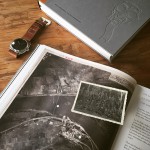 Dated to 1 March 1945, the photo taken by a reconnaissance flight shows one of the pontoon bridges built across the Oder by the Russian troops just shortly before – which became soon later the target for the “Keller Group” just as the frogman wrote it down in his diary. Read more on the diary and various historic documents which helped us to visualize this source of information during our research on a Ref. 3646 / Type D “Kampfschwimmer” watch here.
Dated to 1 March 1945, the photo taken by a reconnaissance flight shows one of the pontoon bridges built across the Oder by the Russian troops just shortly before – which became soon later the target for the “Keller Group” just as the frogman wrote it down in his diary. Read more on the diary and various historic documents which helped us to visualize this source of information during our research on a Ref. 3646 / Type D “Kampfschwimmer” watch here.
The coffee table shot shows page 110-111, chapter II of “History2” next to one of the few original photos of the “Keller Group” taken shortly before their missions at the eastern front (spot some Panerai gear in it). This photo is published on page 94 in the same chapter. The coffee table shot includes also a Ref. 3646 / Type D “Kampfschwimmer”, featured in chapter V of “History2” – the watch of frogman Siegfried Köneke, who was also a member of the “Keller Group”. Read more about this chapter here.
Our two “History” books can be ordered only in our bookstore.
Enjoy reading stories behind these watches!
[Ralf Ehlers & Volker Wiegmann]
The Radiomir which returned from Gibraltar to Italy…
by Volker on Feb.01, 2024, under Allgemein
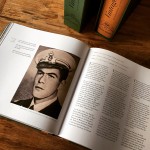 …but alone – without the SLC pilot who used it on his wrist during the mission B.G.5 in December 1942: Licio Visintini.
…but alone – without the SLC pilot who used it on his wrist during the mission B.G.5 in December 1942: Licio Visintini.
Born 1915 and enterred the Royal Italian Navy in 1933, Licio Visintini took part in several missions against the allied fleet in Gibraltar as a member of the Decima MAS. In 1941 Visintini was promoted to Tenente di Vascello. After surviving from SLC missions B.G.3 (May 1941) and B.G.4 (September 1941), carried out by the transport submersible “Scirè” under the command of Junio Valerio Borghese, Visintini returned to Gibraltar undercover in June 1942 where he built the core of the “Orsa Maggiore” on board the tanker Olterra – the hidden base for the SLC units in the bay of Gibraltar.
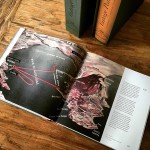 According to legend, Visintini’s „Radiomir Panerai“ was returned to his mother after the end of the Second World War by his former enemy, Lieutenant „Buster“ Crabb (head of the Underwater Working Party in Gibraltar). The return of personal items to relatives showed a great respect that the combatants on different sides had for one another. Crabb, who was himself an experienced diver serving the British Navy, knew from experience all too wellt he level of courage and determination that was neccessary to carry out missions of this kind. Before Visintini’s mother died, she gave the watch to Vittorio Stradi, her son’s best friend. Vittorio Stradi was a „Gamma“ frogman in the Second World War. Fourty years later he passed the watch to his friend Isidoro Mario Nardin, who was also a member of the „Gamma“ frogmen during the Second World War.
According to legend, Visintini’s „Radiomir Panerai“ was returned to his mother after the end of the Second World War by his former enemy, Lieutenant „Buster“ Crabb (head of the Underwater Working Party in Gibraltar). The return of personal items to relatives showed a great respect that the combatants on different sides had for one another. Crabb, who was himself an experienced diver serving the British Navy, knew from experience all too wellt he level of courage and determination that was neccessary to carry out missions of this kind. Before Visintini’s mother died, she gave the watch to Vittorio Stradi, her son’s best friend. Vittorio Stradi was a „Gamma“ frogman in the Second World War. Fourty years later he passed the watch to his friend Isidoro Mario Nardin, who was also a member of the „Gamma“ frogmen during the Second World War.
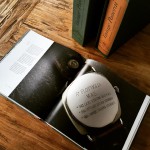 To commemorate the order of ownership, the three names were inscribed for posterity on the caseback, as shown on page 358-359 and 360. For Isidoro Mario Nardin, Licio Visintini’s Panerai watch became a symbol of cameraderie and a memento of his fallen comrade.
To commemorate the order of ownership, the three names were inscribed for posterity on the caseback, as shown on page 358-359 and 360. For Isidoro Mario Nardin, Licio Visintini’s Panerai watch became a symbol of cameraderie and a memento of his fallen comrade.
Chapter II.III in our book “The References” (first volume / 1930’s-1940’s) features the story behind this Ref. 3646 / Type C „Radiomir Panerai“ and its three owners, Licio Visintini (M.O.V.M.), Vittorio Stradi and Isidoro Mario Nardin, on page 350-397.
Information on “The References” 1930’s-1940’s (first volume) can be found here.
Enjoy reading!
[Ralf Ehlers & Volker Wiegmann]
A look into our book “The References” 1930’s-1940’s
by Volker on Dec.23, 2023, under Allgemein
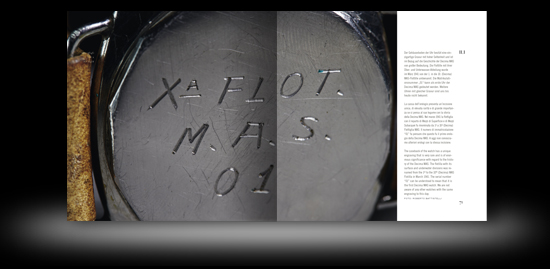
Page 70-71 – engraved caseback of a Ref. 3646 / Type A “Radiomir Panerai”.
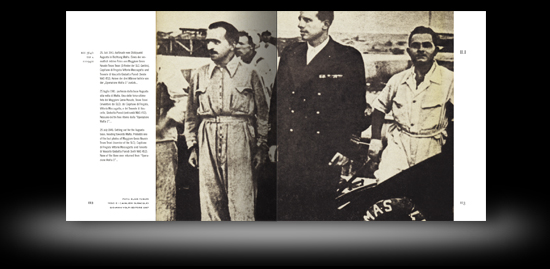
Page 112-113 – 25 July 1941: „Operazione Malta 1“ – setting out for the Augusta base, heading towards Malta: Teseo Tesei (SLC), Vittorio Moccagatta and Giobatta Parodi (MAS 452).
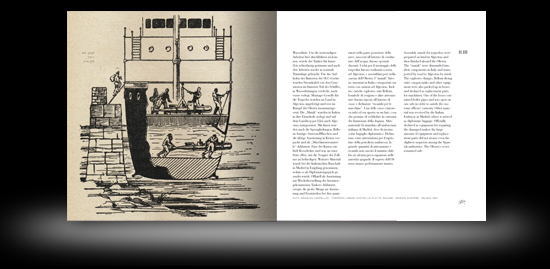
Page 358-359 – contemporary illustration of SLC missions starting from the “Olterra” in the Bay of Gibraltar (1942 and 1943).
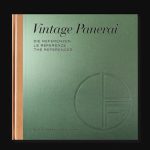 “The References” 1930’s-1940’s at a glance:
“The References” 1930’s-1940’s at a glance:
33 Vintage Panerai watches, history, instruments and straps of the 1930’s-1940’s. Featured References: 2533, 3646, the Mare Nostrum chronograph and compasses.
26 x 26 cm, 696 pages, trilingual (German, Italian and English language in one book), 19 database charts, 383 illustrations, including rare historic photos from the 2nd World War, hardback jacket, slipcase.
Visit our bookstore and enjoy reading soon!
Hammer’s Ref. 3646 / Type B is up for auction
by Volker on Nov.25, 2023, under General
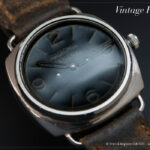 Sotheby’s New York will auction a Ref. 3646 / Type B with riveted plastic dial in their Important Watches sale on 7 December 2023.
Sotheby’s New York will auction a Ref. 3646 / Type B with riveted plastic dial in their Important Watches sale on 7 December 2023.
This 3646 is well known in the paneristi community and has been consigned by our dear friend Hammer along with other watches from his personal collection. You can read more on this rare Ref. 3646 / Type B “Radiomir Panerai” from 1941 here in our watch point.
[Photo courtesy of Martin Wilmsen]
Sotheby’s New York to auction a Ref. 3646 / Type B
by Volker on Nov.25, 2023, under Watch Point
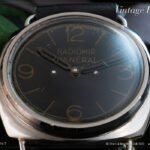 Sotheby’s New York will auction a rare Ref. 3646 / Type B with riveted plastic dial – read more at their website here.
Sotheby’s New York will auction a rare Ref. 3646 / Type B with riveted plastic dial – read more at their website here.
This specimen is one of only 21 Ref. 3646 / Type B watches known in our database until today. It has been recorded in 2013 and still remains the watch with the lowest case number within all known Ref. 3646 / Type B watches, bearing the small Oyster Watch Co hallmark on the inside of the caseback (“full polish” decoration) with its seven-digit casing reference number and the reference number 3646. You can read more on our 3646 caseback classification here.
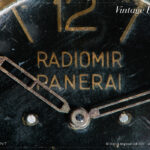 The watch is fitted with a riveted plastic dial, which has a smaller diameter than the sandwich dials, visible by the little gap between dial and (high) bezel. It bears the famous “Radiomir Panerai” writing below 12 o’clock. The surface of the plastic dial has become distorted over time. The luminous material under the surface in the numerals and indices appears lightly raised, while the other areas have become recessed (see also photo here).
The watch is fitted with a riveted plastic dial, which has a smaller diameter than the sandwich dials, visible by the little gap between dial and (high) bezel. It bears the famous “Radiomir Panerai” writing below 12 o’clock. The surface of the plastic dial has become distorted over time. The luminous material under the surface in the numerals and indices appears lightly raised, while the other areas have become recessed (see also photo here).
The watch is fitted with a Rolex crown (Type 13) with “Oyster Patent +” lettering. The steel hands on this watch have become competely skeletonized. The dodecagonal caseback of the watch does not have an outer engraving. The 47 mm steel case has the typical breadth of the curved strap loop, a common feature on watches from the early series (Type A to Type C) visible in the photo below.
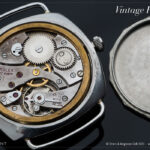 Features of the watch:
Features of the watch:
Reference: 3646 / Type B
Dial: “Radiomir Panerai” (sandwich, riveted plastic dial)
Case number: 1009XXX
Movement: Rolex Cal. 618 / Type 1
We have featured this watch in our book “The References” 1930’s-1940’s in chapter II.II on page 173-189. It was one of several historic Panerai watches Hammer provided to us in 2014 to be featured in our books. We hope our friend’s beloved 3646 will find a good new home and that it remain surfaced in the Vintage Panerai collectors world. [Ralf Ehlers & Volker Wiegmann]
[Photos courtesy of Martin Wilmsen]
“Il cavallo di Troia” – the secret SLC base
by Volker on Nov.23, 2023, under Allgemein
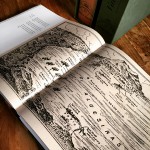 Enemy ships in the harbour of Gibraltar have been in the sight of the Royal Italian Navy since September 1940. After several attacks by “Gamma” frogmen and SLC units, ideas to build a secret base of the Decima MAS were realized in the second half of the year 1942. Convoy ships for the United States were beginning to arrive in quantity. The numbers of potential targets at anchor in the Bay of Algeciras were growing almost daily.
Enemy ships in the harbour of Gibraltar have been in the sight of the Royal Italian Navy since September 1940. After several attacks by “Gamma” frogmen and SLC units, ideas to build a secret base of the Decima MAS were realized in the second half of the year 1942. Convoy ships for the United States were beginning to arrive in quantity. The numbers of potential targets at anchor in the Bay of Algeciras were growing almost daily.
Earlier in 1942, a base for the Decima MAS “Gamma” frogmen was established in the Villa Carmela near La Linea from where several missions were carried out against British merchant ships (see page 126-131 / chapter II.I). During the months of shaping Villa Carmela into an advanced base, the idea for a bigger and much more effective operation had taken form in the mind of Licio Visintini, one of the SLC pilots of the mission B.G.4 in September 1941 (see page 374-381 / chapter II.III) which was carried out from the submarine Scirè.
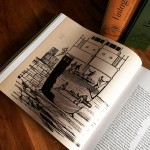 Before the new base was ready for action, each attack at Gibraltar had required a long submarine voyage, air and land transportation of the attack-teams, the shipping of supplies and weapons, arrangements for rendezvous, an approach by submarine, and finally the task of smuggling the survivors back to Italy thru neutral Spanish territory.
Before the new base was ready for action, each attack at Gibraltar had required a long submarine voyage, air and land transportation of the attack-teams, the shipping of supplies and weapons, arrangements for rendezvous, an approach by submarine, and finally the task of smuggling the survivors back to Italy thru neutral Spanish territory.
Licio Visintini’s idea became real with turning the anchored ship Olterra inside the pier of Algeciras into a secret base for SLC missions. Visintini and further technical specialists replaced the original crew of the Olterra. An assembly workshop for the SLC devices (which arrived in sections, declared as spare parts for the damaged ship) was established in the hull. A portside cabin of the Olterra became the observation post with an excellent view of Gibraltar harbour. Finally, a folding door on the port side bow (see coffee table shot of page 386-387 /chapter II.III) became the exit door for the SLC units below waterline to reach their targets – and to return back into the hull of the Olterra. After months of intensive work in total secrecy, the inconspicious ship Olterra was turned into a Trojan Horse – “il cavallo di Troia” – and six men were ready for action with their SLC devices.
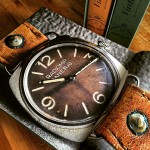 The Olterra was starting point of the following SLC missions against enemy ships in the bay of Algeciras / Gibraltar harbour: B.G.5 (7/8 December 1942), B.G.6 (7/8 May 1943) and B.G.7 (3/4 August 1943). Our book “The References” 1930’s-1940’s features two Ref. 3646 watches which were used during these missions.
The Olterra was starting point of the following SLC missions against enemy ships in the bay of Algeciras / Gibraltar harbour: B.G.5 (7/8 December 1942), B.G.6 (7/8 May 1943) and B.G.7 (3/4 August 1943). Our book “The References” 1930’s-1940’s features two Ref. 3646 watches which were used during these missions.
The Ref. 3646 / Type A “Radiomir Panerai” watch of Ernesto Notari is featured in chapter II.I (page 58-91 / see coffee table shot on the left) – more on this watch and its history can be found here. The Ref. 3646 / Type C “Radiomir Panerai” watch of Licio Visintini is featured in chapter II.III (page 350-367) – more on this watch and the history behind can be found here. The new “The References” books can be ordered only in our bookstore.
Enjoy reading!
[Ralf Ehlers & Volker Wiegmann]
Training scene in the summer of 1944
by Volker on May.26, 2023, under Allgemein
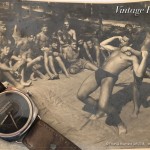 A few days ago we received an interesting photo from the grandson of a German “Kampfschwimmer”. With his support we were able to add the Ref. 3646 / Type B “Radiomir Panerai” into our database last year – read more here.
A few days ago we received an interesting photo from the grandson of a German “Kampfschwimmer”. With his support we were able to add the Ref. 3646 / Type B “Radiomir Panerai” into our database last year – read more here.
Actually, the photo is not new to us. It has been published many years ago in Cajus Bekker’s book “Einzelkämpfer auf See” in 1968 and again in 1978. However, there were never published names of the frogmen in the captions of these two books. Until now: The backside of the original paper photo showed pencil written names of the men which were captured in the photo, which helped us now to identify and link them to other photos in our archives. We have published a photo, taken from a slightly different perspective, showing the same training scene, in chapter V of our book “History2” on page 460.
The photos were taken in the summer of 1944 on the island of San Giorgio (south-west of Venice harbour), showing the training in hand-to-hand combat, which was a fixed part of their training along with other different sporting disciplines. One of the frogmen in the photo is the first owner of the Ref. 3646 / Type B watch on the left.
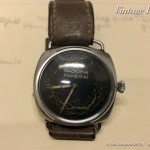 Read more on the activities on the island of San Giorgio in chapter I of our book “History1” including rare historic documents and aerial photographs from the Allied Forces intelligence.
Read more on the activities on the island of San Giorgio in chapter I of our book “History1” including rare historic documents and aerial photographs from the Allied Forces intelligence.
Our special thanks to the frogman’s grandson who provided the photo above (including the additional informations on ist backside in shape of handwritten names), on which he placed the Ref. 3646 / Type B “Radiomir Panerai” of his grandfather. [Ralf Ehlers & Volker Wiegmann]
Inventors, pilots and a royal visitor…
by Volker on May.14, 2023, under Allgemein
The first watches for the pilots of the “new weapon” SLC were delivered in the middle of the 1930’s by Guido Panerai & Figlio to the Commando del 1° Gruppo Sommergibili of the Royal Italian Navy. According to the timeline of the development of the top secret slow running torpedos (siluro a lenta corsa, short: SLC) by the inventors Teseo Tesei and Elios Toschi, waterproof and luminous instruments for the pilots were necessary to carry out proper exercises and to control the SLC in depth and darkness.
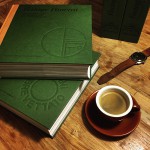 The chapters I and II, dedicated to the first watches for underwater use (Ref. 2533 and 3646) take the readers of our book “The References” 1930’s-1940’s into these early years. Teseo Tesei and Elios Toschi’s ideas became real. But strategic decisions after the Italo-Ethiopian War stopped the secret SLC project. The tests with these small weapons were archived and the Royal Italian Navy focused their interest in huge battleships, cruisers and destroyers.
The chapters I and II, dedicated to the first watches for underwater use (Ref. 2533 and 3646) take the readers of our book “The References” 1930’s-1940’s into these early years. Teseo Tesei and Elios Toschi’s ideas became real. But strategic decisions after the Italo-Ethiopian War stopped the secret SLC project. The tests with these small weapons were archived and the Royal Italian Navy focused their interest in huge battleships, cruisers and destroyers.
The SLC project was re-started by the 1st Flottiglia MAS in 1939 at the advent of the Second World War. With the first missions of the Mezzi d’Assalto carried out from August 1940 onwards, the demand for skilled operators as well as new equipment – and more instruments for the operators – grew fast. An early Ref. 3646 / Type A, dated to April 1940, is featured in chapter II.I followed by the timeline of the missions carried out by the operators of the Decima Flottiglia MAS, the special commandos of the Royal Italian Navy.
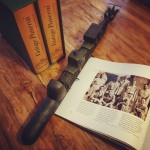 The photo shows page 96 of “The References” with a historic photo from June 1940: The two inventors of the SLC, Teseo Tesei and Elios Toschi, Alberto Franzini and Gino Birindelli above their co-pilots stand together with a royal visitor: Principe Aimone di Savoia Aosta, Duca di Spoleto – just a few weeks before the first missions of the new weapon SLC were about to write naval history.
The photo shows page 96 of “The References” with a historic photo from June 1940: The two inventors of the SLC, Teseo Tesei and Elios Toschi, Alberto Franzini and Gino Birindelli above their co-pilots stand together with a royal visitor: Principe Aimone di Savoia Aosta, Duca di Spoleto – just a few weeks before the first missions of the new weapon SLC were about to write naval history.
Read more about “The birth of a legend – the first Panerai watches (1935-1939)” in chapter I, followed by the timeline of the missions during the Second World War in chapter II.I – more information on the historic content in our “The References” book set with a total of 1392 pages can be found here. Read about the featured watches from Guido Panerai & Figlio in the first and second volume here.

